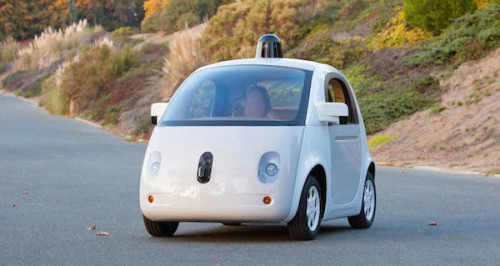Serious technical difficulties regarding the safety of autonomous vehicles have been noticed by the executives who run automotive development, according to the New York Times.
Apparently, the real world of city streets has proved to be more complicated than the simple suburbs of the Silicon Valley area, where initial self-driving tests were run.
Below, Google’s 2014 prototype model of self-driving car dinked around the neighborhood at a maximum speed of 25 mph.

The article mentions the 2018 accident that caused a death in Tempe, Arizona. The major pitch of self-driving cars was that they would be perfectly safe, unlike human drivers who are responsible for more than 30,000 traffic fatalities per year in the US.
A whole industry was created and put on the fast track to get autonomous cars on the road.
But now, the brakes are on, and it’s just as well the self-driving juggernaut gets dialed down. More that three million Americans drive for a living, and replacing them with robots was going to be a big hit on the jobs economy. It’s better that widespread use of self-driving vehicles is postponed for a long time.
Despite high hopes, self-driving cars are ‘way in the future’, New York Times, July 17, 2019
A year ago, Detroit and Silicon Valley had visions of putting thousands of self-driving taxis on the road in 2019, ushering in an age of driverless cars.
Most of those cars have yet to arrive — and it is likely to be years before they do. Several carmakers and technology companies have concluded that making autonomous vehicles is going to be harder, slower and costlier than they thought.
“We overestimated the arrival of autonomous vehicles,” Ford’s chief executive, Jim Hackett, said at the Detroit Economic Club in April.
In the most recent sign of the scramble to regroup, Ford and Volkswagen said last week that they were teaming up to tackle the self-driving challenge.
The two automakers plan to use autonomous-vehicle technology from a Pittsburgh startup, Argo AI, in ride-sharing services in a few urban zones as early as 2021. But Argo’s chief executive, Bryan Salesky, said the industry’s bigger promise of creating driverless cars that could go anywhere was “way in the future.”
[. . .]
A year ago, many industry executives exuded much greater certainty. They thought that their engineers had solved the most vexing technical problems and promised that self-driving cars would be shuttling people around town in at least several cities by sometime this year.
“There was this incredible optimism,” said Sam Abuelsamid, an analyst at Navigant Research. “Companies thought this was a very straightforward problem. You just throw in some sensors and artificial intelligence and it would be easy to do.”
The industry’s unbridled confidence was quickly dented when a self-driving car being tested by Uber hit and killed a woman walking a bicycle across a street last year in Tempe, Arizona. A safety driver was at the wheel of the vehicle, but was watching a TV show on her phone just before the crash, according to the Tempe Police Department.
Since that fatality, “almost everybody has reset their expectations,” Abuelsamid said. It was believed to be the first pedestrian death involving a self-driving vehicle. Elsewhere in the United States, three Tesla drivers have died in crashes that occurred while the company’s Autopilot driver-assistance system was engaged and both it and the drivers failed to detect and react to hazards.


